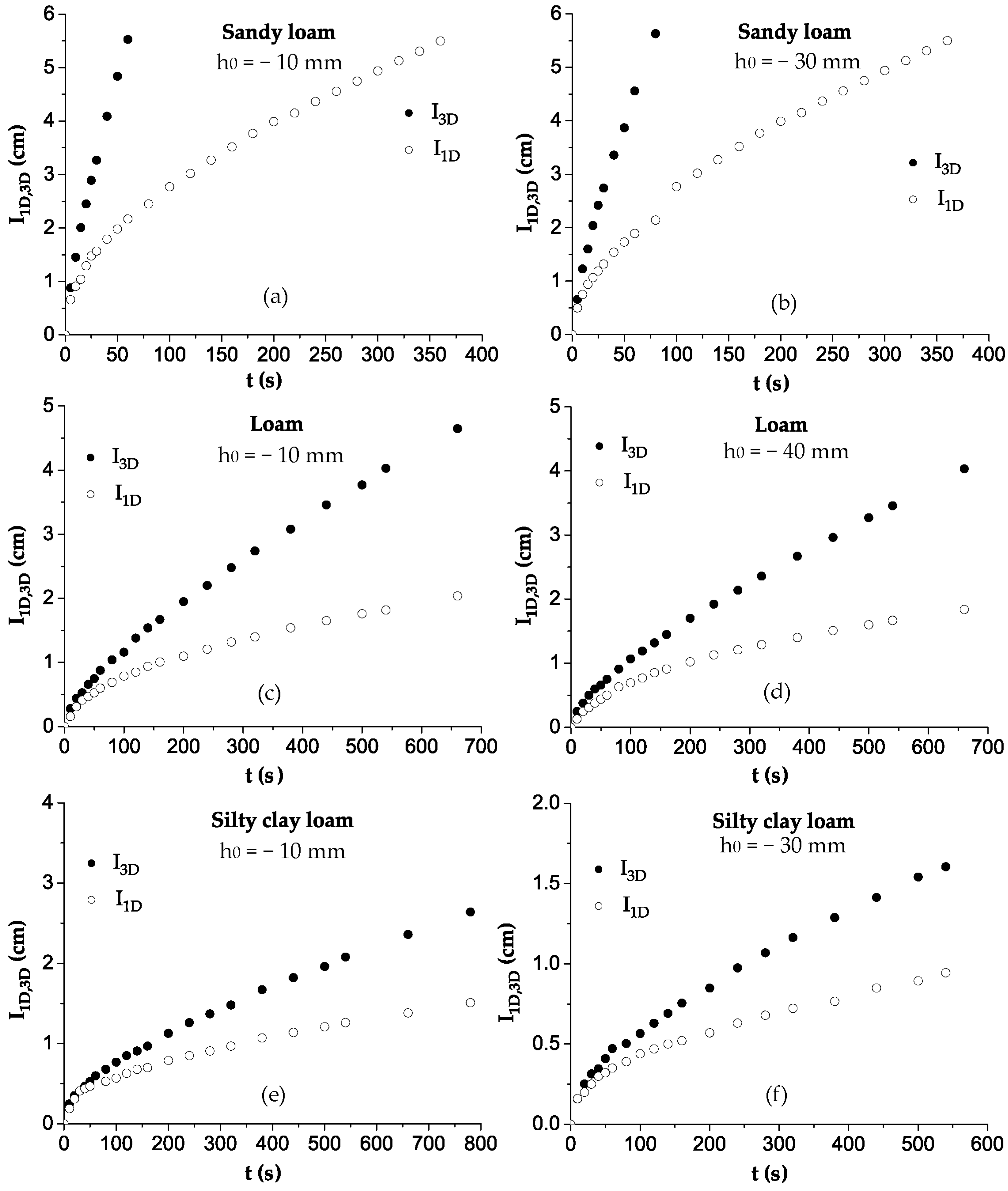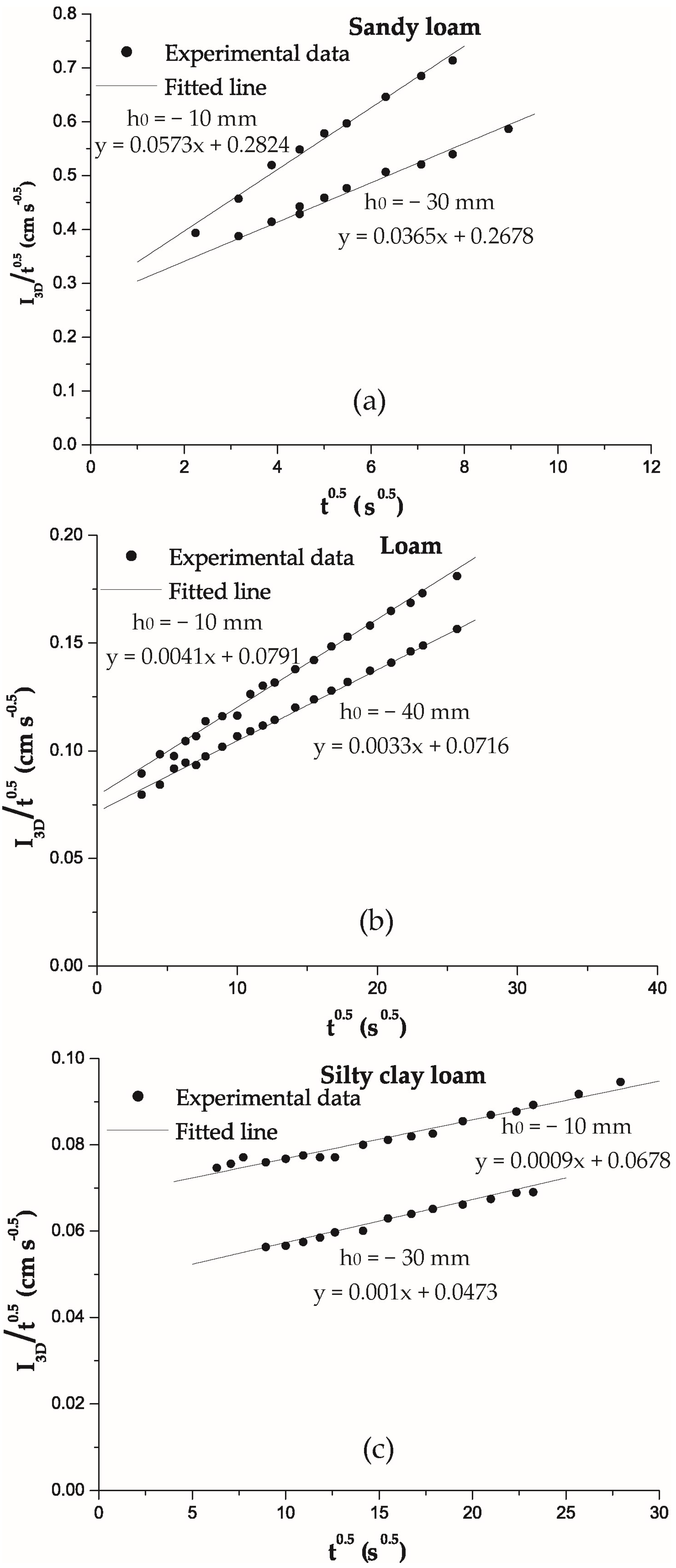A Note on One- and Three-Dimensional Infiltration Analysis from a Mini Disc Infiltrometer
Abstract
:1. Introduction
2. Materials and Methods
2.1. Three- and One-Dimensional Experiments Using the Mini Disc Infiltrometer
2.2. Estimation of Sorptivity
2.3. Determination of Soil Water Content
3. Results and Discussion
3.1. Estimation of Sorptivity
3.2. Estimation of Difference between Three- and One-Dimensional Infiltration Data
3.3. Effect of γ Parameter to Hydraulic Conductivity Calculation
4. Conclusions
Author Contributions
Funding
Conflicts of Interest
References
- Smettem, K.R.J.; Parlange, J.Y.; Ross, P.J.; Haverkamp, R. Three-dimensional analysis of infiltration from the disc infiltrometer: 1. A capillary-based theory. Water Resour. Res. 1994, 30, 2925–2929. [Google Scholar] [CrossRef] [Green Version]
- Smettem, K.R.J.; Clothier, B.E. Measuring unsaturated sorptivity and hydraulic conductivity using multiple disc permeameters. J. Soil Sci. 1989, 40, 563–568. [Google Scholar] [CrossRef]
- Warrick, A.W. Models for disc infiltrometers. Water Resour. Res. 1992, 28, 1319–1327. [Google Scholar] [CrossRef]
- Haverkamp, R.; Ross, P.J.; Smettem, K.R.J.; Parlange, J.Y. Three dimensional analysis of infiltration from disc infiltrometer: 2. Physically-based infiltration equation. Water Resour. Res. 1994, 30, 2931–2935. [Google Scholar] [CrossRef]
- Vandervaere, J.P.; Vauclin, M.; Elrick, D.E. Transient flow from tension infiltrometers: I. The two parameter equation. Soil Sci. Soc. Am. J. 2000, 64, 1263–1272. [Google Scholar] [CrossRef]
- Smettem, K.R.J. Characterization of water entry into a soil with a contrasting textural class: Spatial variability of infiltration parameters and influence of macroporosity. Soil Sci. 1987, 144, 167–174. [Google Scholar] [CrossRef]
- Mohanty, B.P.; Ankeny, M.D.; Horton, R.; Kanwar, R.S. Spatial analysis of hydraulic conductivity measured using disc infiltrometers. Water Resour. Res. 1994, 30, 2489–2498. [Google Scholar] [CrossRef]
- Shouse, P.J.; Mohanty, B.P. Scaling of near-saturated hydraulic conductivity measured using disc infiltrometers. Water Resour. Res. 1998, 34, 1195–1205. [Google Scholar] [CrossRef] [Green Version]
- Quadri, M.B.; Angulo-Jaramillo, R.; Vauclin, M.; Clothier, B.E.; Green, S.R. Axisymmetric transport of water and solute underneath a disk permeameter: Experiments and numerical model. Soil Sci. Soc. Am. J. 1994, 58, 696–703. [Google Scholar] [CrossRef]
- Smettem, K.R.J.; Ross, P.J.; Haverkamp, R.; Parlange, J.Y. Three-dimensional analysis of infiltration from the disc infiltrometer: 3. Parameter estimation using a double-disk tension infiltrometer. Water Resour. Res. 1995, 31, 2491–2495. [Google Scholar] [CrossRef]
- Lassabatere, L.; Angulo-Jaramillo, R.; Soria-Ugalde, J.M.; Simunek, J.; Haverkamp, R. Numerical evaluation of a set of analytical infiltration equations. Water Resour. Res. 2009, 45, W12415. [Google Scholar] [CrossRef]
- Warrick, A.W.; Lazarovitch, N. Infiltration from a strip source. Water Resour. Res. 2007, 43, W03420. [Google Scholar] [CrossRef]
- Fuentes, C.R.; Haverkamp, R.; Parlange, J.Y. Parameter constraints on closed-form soil water relationships. J. Hydrol. 1992, 137, 117–142. [Google Scholar] [CrossRef]
- Warrick, A.W.; Lazarovitch, N.; Furman, A.; Zcrihun, D. Explicit infiltration function for furrows. J. Irrig. Drain. Eng. 2007, 133, 307–313. [Google Scholar] [CrossRef]
- Clothier, B.E.; White, I. Measurement of sorptivity and soil water diffusivity in the field. Soil Sci. Soc. Am. J. 1981, 45, 241–245. [Google Scholar] [CrossRef]
- Ankeny, M.D.; Ahmed, Μ.; Kaspar, T.C.; Horton, R. Simple field method for determining unsaturated hydraulic conductivity. Soil Sci. Soc. Am. J. 1991, 55, 467–470. [Google Scholar] [CrossRef]
- Reynolds, W.D.; Elrick, E.D. Determination of hydraulic conductivity using a tension infiltrometer. Soil Sci. Soc. Am. J. 1991, 55, 633–639. [Google Scholar] [CrossRef]
- Zhang, R. Infiltration models for the disc infiltrometer. Soil Sci. Soc. Am. J. 1997, 61, 1597–1603. [Google Scholar] [CrossRef]
- Vandervaere, J.P.; Vauclin, M.; Elrick, D.E. Transient flow from tension infiltrometers: II. Four methods to determine sorptivity and conductivity. Soil Sci. Soc. Am. J. 2000, 64, 1272–1284. [Google Scholar] [CrossRef]
- Latorre, B.; Moret-Fernández, D.; Peña, C. Estimate of soil hydraulic properties from disc infiltrometer three-dimensional infiltration curve: Theoretical analysis and field applicability. Procedia Environ. Sci. 2013, 19, 580–589. [Google Scholar] [CrossRef]
- Wooding, R.A. Steady infiltration from shallow circular pond. Water Resour. Res. 1968, 4, 1259–1273. [Google Scholar] [CrossRef]
- Vandervaere, J.P. The soil solution phase. In Methods of Soil Analysis: Part 4, Physical Methods; Dane, J.H., Topp, G.C., Eds.; Soil Science Society of America (SSSA, Inc.): Madison, WI, USA, 2002; pp. 889–894. [Google Scholar]
- Philip, J.R. The theory of infiltration: 4. Sorptivity and algebraic infiltration equations. Soil Sci. 1957, 84, 257–264. [Google Scholar] [CrossRef]
- Dohnal, M.; Dusek, J.; Vogel, T. Improving hydraulic conductivity estimates from mini disk infiltrometer measurements for soils with wide pore-size distributions. Soil Sci. Soc. Am. J. 2010, 74, 804–811. [Google Scholar] [CrossRef]
- Smiles, D.E.; Knight, J.H. A note on the use of the Philip infiltration equation. Aust. J. Soil Res. 1976, 14, 103–108. [Google Scholar] [CrossRef]
- Decagon Devices. Mini Disc Infiltrometer, User’s Manual; Decagon Devices Inc.: Pullman, DC, USA, 2007. [Google Scholar]
- Kargas, G.; Londra, P.; Anastasiou, K. Investigation of the relationship between three- and one-dimensional infiltration using a mini disc infiltrometer. In Proceedings of the 3rd EWaS International Conference on “Insights on the Water-Energy-Food Nexus”, Lefkada Island, Greece, 27–30 June 2018. [Google Scholar]
- Minasny, B.; McBratney, A.B. Estimation of sorptivity from disc-permeameter measurements. Geoderma 2000, 95, 305–324. [Google Scholar] [CrossRef]
- Vandervaere, J.P.; Peugeot, C.; Vauclin, M.; Angulo-Jaramillo, R.; Lebel, T. Estimating hydraulic conductivity of crusted soils using disc infiltrometers and minitensiometers. J. Hydrol. 1997, 188–189, 203–223. [Google Scholar] [CrossRef]
- Perroux, K.M.; White, I. Designs for disc permeameters. Soil Sci. Soc. Am. J. 1988, 52, 1205–1215. [Google Scholar] [CrossRef]
- Haverkamp, R.; Debionne, D.; Viallet, P.; Angulo-Jaramillo, R.; de Condapa, D. Soil properties and moisture movement in the unsaturated zone. In The Handbook of Groundwater Engineering; Delleur, J.W., Ed.; CRC Press: Boca Raton, FL, USA, 2005; pp. 1–59. [Google Scholar]



| Soil Type | Clay (%) | Silt (%) | Sand (%) | ρφ (g cm−3) |
|---|---|---|---|---|
| Sandy loam | 13.2 | 8 | 78.8 | 1.41 |
| Loam | 20.0 | 38 | 42.0 | 1.17 |
| Silty clay loam | 36.5 | 52 | 11.5 | 1.23 |
| Soil Type | Pressure Head, h0 (mm) | Water Content, θ0 (cm3 cm−3) | Soil Sorptivity, S0 (cm s−0.5) | R2 |
|---|---|---|---|---|
| Sandy loam | −10 | 0.399 | 0.284 | 0.997 |
| −30 | 0.385 | 0.241 | 0.999 | |
| Loam | −10 | 0.385 | 0.072 | 0.970 |
| −40 | 0.369 | 0.063 | 0.958 | |
| Silty clay loam | −10 | 0.464 | 0.061 | 0.990 |
| −30 | 0.446 | 0.046 | 0.990 |
| Soil Type | Pressure Head, h0 (mm) | γ | Slope (cm min−1) | R2 |
|---|---|---|---|---|
| Sandy loam | −10 | 0.569 | 0.0569 | 0.996 |
| −30 | 0.588 | 0.0440 | 0.996 | |
| Loam | −10 | 0.614 | 0.0041 | 0.998 |
| −40 | 0.615 | 0.0033 | 0.995 | |
| Silty clay loam | −10 | 0.538 | 0.0020 | 0.998 |
| −30 | 0.561 | 0.0013 | 0.989 |
© 2018 by the authors. Licensee MDPI, Basel, Switzerland. This article is an open access article distributed under the terms and conditions of the Creative Commons Attribution (CC BY) license (http://creativecommons.org/licenses/by/4.0/).
Share and Cite
Kargas, G.; Londra, P.; Anastasiou, K.; Kerkides, P. A Note on One- and Three-Dimensional Infiltration Analysis from a Mini Disc Infiltrometer. Water 2018, 10, 1783. https://doi.org/10.3390/w10121783
Kargas G, Londra P, Anastasiou K, Kerkides P. A Note on One- and Three-Dimensional Infiltration Analysis from a Mini Disc Infiltrometer. Water. 2018; 10(12):1783. https://doi.org/10.3390/w10121783
Chicago/Turabian StyleKargas, George, Paraskevi Londra, Konstantinos Anastasiou, and Petros Kerkides. 2018. "A Note on One- and Three-Dimensional Infiltration Analysis from a Mini Disc Infiltrometer" Water 10, no. 12: 1783. https://doi.org/10.3390/w10121783
APA StyleKargas, G., Londra, P., Anastasiou, K., & Kerkides, P. (2018). A Note on One- and Three-Dimensional Infiltration Analysis from a Mini Disc Infiltrometer. Water, 10(12), 1783. https://doi.org/10.3390/w10121783








